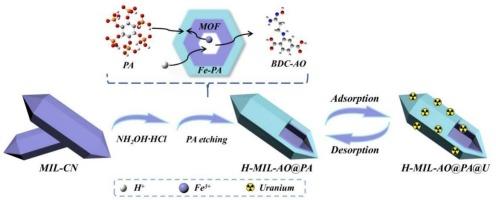Phytic acid-mediated construction of hollow metal-organic framework nanorods with dual amidoxime and phosphate functionalities for uranium adsorption
IF 6.9
2区 材料科学
Q2 CHEMISTRY, PHYSICAL
引用次数: 0
Abstract
Metal organic frameworks (MOFs) has aroused mounting attention in the field of uranium extraction from seawater. However, the attainment of high adsorption efficiency persists as a daunting challenge. Reasonable optimization of the pore morphology and structure of MOFs, along with precise grafting of multi-affinity sites, is pivotal for enhancing adsorption performance. Herein, we employed a synchronous synthesis strategy involving phytic acid (PA) − mediated hollowing and functionalization to optimize pore structure and functional sites simultaneously for H-MIL-AO@PA3. PA showed selective etching of the MIL-AO core layer, and we also optimized the reaction time to control structure evolution. H-MIL-AO@PA3 features a unique “dual-functional group − hollow pore channel” system, which enables highly efficient uranium adsorption (Qm = 406.50 mg g-1) according to the Langmuir model. Moreover, H-MIL-AO@PA3 demonstrates high selectivity (Kd > 4.2 × 105 mL g-1) and excellent reusability over five adsorption/desorption cycles for uranium. The adsorption process of H-MIL-AO@PA3 is in excellent agreement with the pseudo-second-order model, and equilibrium is attained within 30 min (C0 = 20 mg L-1). This work provides a new approach for the design of high-performance of adsorbents for uranium extraction from seawater.


植酸介导的具有偕胺肟和磷酸盐双官能团的中空金属-有机框架纳米棒的构建对铀的吸附
金属有机骨架(MOFs)在海水提铀领域受到越来越多的关注。然而,实现高吸附效率仍然是一个艰巨的挑战。合理优化mof的孔隙形态和结构,精确接枝多亲和位点,是提高mof吸附性能的关键。在此,我们采用同步合成策略,包括植酸(PA)介导的中空和功能化,同时优化H-MIL-AO@PA3的孔结构和功能位点。PA对MIL-AO核心层进行了选择性刻蚀,并优化了反应时间来控制结构的演变。H-MIL-AO@PA3具有独特的“双官能团-中空孔隙通道”系统,根据Langmuir模型,该系统能够高效吸附铀(Qm = 406.50mg g - 1)。此外,H-MIL-AO@PA3对铀具有高选择性(Kd >; 4.2 × 105 mL g−1),并且在5个吸附/解吸循环中具有良好的可重复使用性。H-MIL-AO@PA3的吸附过程与拟二阶模型非常吻合,在30 min内达到平衡(C0 = 20 mg L-1)。本研究为海水提铀吸附剂的设计提供了一种新的思路。
本文章由计算机程序翻译,如有差异,请以英文原文为准。
求助全文
约1分钟内获得全文
求助全文
来源期刊

Applied Surface Science
工程技术-材料科学:膜
CiteScore
12.50
自引率
7.50%
发文量
3393
审稿时长
67 days
期刊介绍:
Applied Surface Science covers topics contributing to a better understanding of surfaces, interfaces, nanostructures and their applications. The journal is concerned with scientific research on the atomic and molecular level of material properties determined with specific surface analytical techniques and/or computational methods, as well as the processing of such structures.
 求助内容:
求助内容: 应助结果提醒方式:
应助结果提醒方式:


